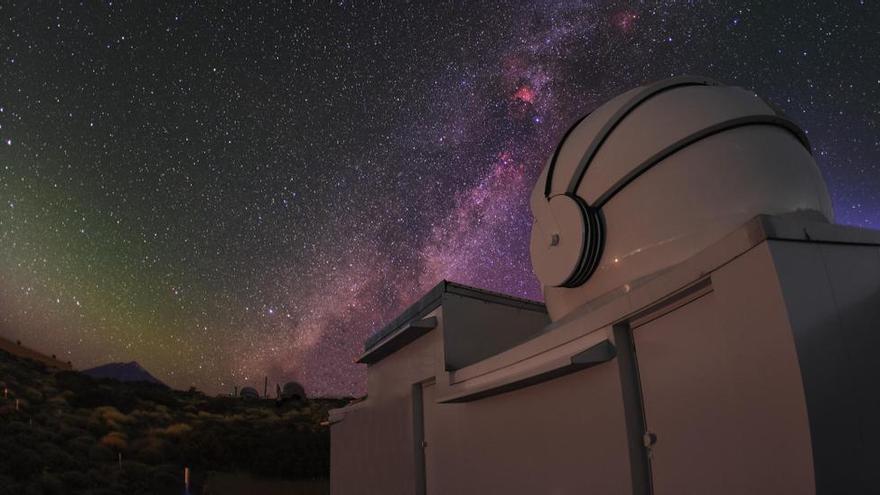The first telescopes private Canarians, installed in the Teide Observatory, they are going to help the POT to develop one of the most important space missions of the century: the study of the most valuable asteroid in the universe. The four robotic telescopes of the project Two meter twin telescope (TTT), from the Canarian company Light Bridges, will be a key piece for the characterization of metal-rich asteroids (M-type) in our solar system. The step before launching a large mission to study in the place asteroid Psyche (or Psyche) 16, orbiting between Mars and Jupiter, to be launched in October of this year.
Psyche 16 is a precious and rare asteroid made of metals like iron and nickel – instead of rock and ice – that is found wandering the asteroid belt of our solar system. Discovered in 1852 by the Neapolitan astronomer and mathematician Annibale de Gasparis, this object is believed to be the nucleus of a disintegrating protoplanet. The object, 226 kilometers in diameter and located 370 million kilometers from planet Earth, could unravel the mysteries about the core of our own planet, made up of the same metals. Circumstance that has drawn the attention of NASA, which made a probe this year to study it and try to understand what the formation of other worlds is like.
But the great wandering rock also has economic value. And it is that, in addition to iron and nickel, it could also house gold, platinum and copper. Its value, according to NASA itself, is 10 trillion dollars. A figure that becomes almost irrelevant to the 100 trillion dollars on which the world economy is based. A sum of money that has caught the attention of billionaire Elon Musk whose ambition, however, is not to study the object, but to extract all that natural space wealth.
Canary Islands it is a key piece for the space mission to be successful. As Noemí Pinilla Alonso, an astronomer at the Space Institute of the University of Central Florida and NASA, explains before launching it, «it is important to understand the formation and evolution of the solar system in general lines.» The researcher, who is also responsible for this project in the Islands, insists that the objective is «to learn more about the population of asteroids with similar characteristics to Psyche 16», so that it can be concluded if Psyche is as special as it seems or it is only part of a hitherto unknown group of asteroids.
international collaboration
This action is framed within the collaboration that has been articulated between the University of Central Florida and the Canarian company Light Bridges. A company created and based in the Canary Islands whose objective is to help the Spanish scientific community, and specifically the Instituto de Astrofísica de Canarias, to achieve relevant scientific objectives. In addition to their international relevance, what makes the TTTs special is that they are privately owned and are the result of a pioneering formula through which investors have put their money through the tax incentives in force on the islands, such as the Reserve for Investments in the Canary Islands (RIC). Which shows that these formulas that the Archipelago has not only serve for tourism or construction, but also for science.
In this case, the TTT will focus on the study of asteroids, but the four robotic telescopes are «very versatile» and will be able to detect different events in the universe. They thus have the ability to see sporadic events, such as supernovae or gamma ray bursts (GRBs); events that need observation time, such as knowing the characteristics of exoplanets or black holes; as well as studying large structures, such as stellar halos, intracluster light or ultra-diffuse galaxies.
It can also be used to learn the characteristics of trans-Neptunian objects (icy bodies that reside beyond Neptune, such as Pluto) or to watch out for potentially dangerous objects, that is, the largest asteroids and close to Earth’s orbit. “They are highly specialized photographic laboratories that translate the photons from the stars into massive digital data”, explain the promoters of Light Bridges.
This collaboration, however, not only remains in the scientific field, but also in the educational and labor spheres, given that, in addition to offering observation time from the TTT telescopes, it includes sending a researcher for professional training at the Space Institute of Florida (FSI), in Orlando during the next academic year.
The final objective of the company is to ensure that the Canary Islands host the TMT
Related news
In addition to contributing to the scientific objectives that may arise in the Canary Islands or in the world through the Comprehensive financing of new telescopes, the company has another priority objective: to serve as a boost for the Canary Islands to be chosen as the final destination of the Thirty Meter Telescope (TMT). «The TMT seeks to advance the frontier of knowledge on numerous fronts,» they explain from the company, from which they insist that perhaps the most «fascinating» objective is the question of whether there is life on other planets. «In our opinion, this is the most relevant science that exists; once the question has been posed, helping the Canary Islands to realize the answer is our main challenge and objective,» explains the company.
The researcher and promoter of Light Bridges, Antonio Maude, insists that this company of Canary origin «designs and promotes private astronomical infrastructures in the Canary Islands to achieve public objectives of relevant science.» The company built these telescopes in the Canary Islands to take advantage of «the unique scientific treasure in nature», the sky of the Archipelago. «We have been making uninterrupted observations for a month, without clouds and with exceptional technical conditions. It is incredible,» the company highlights.

